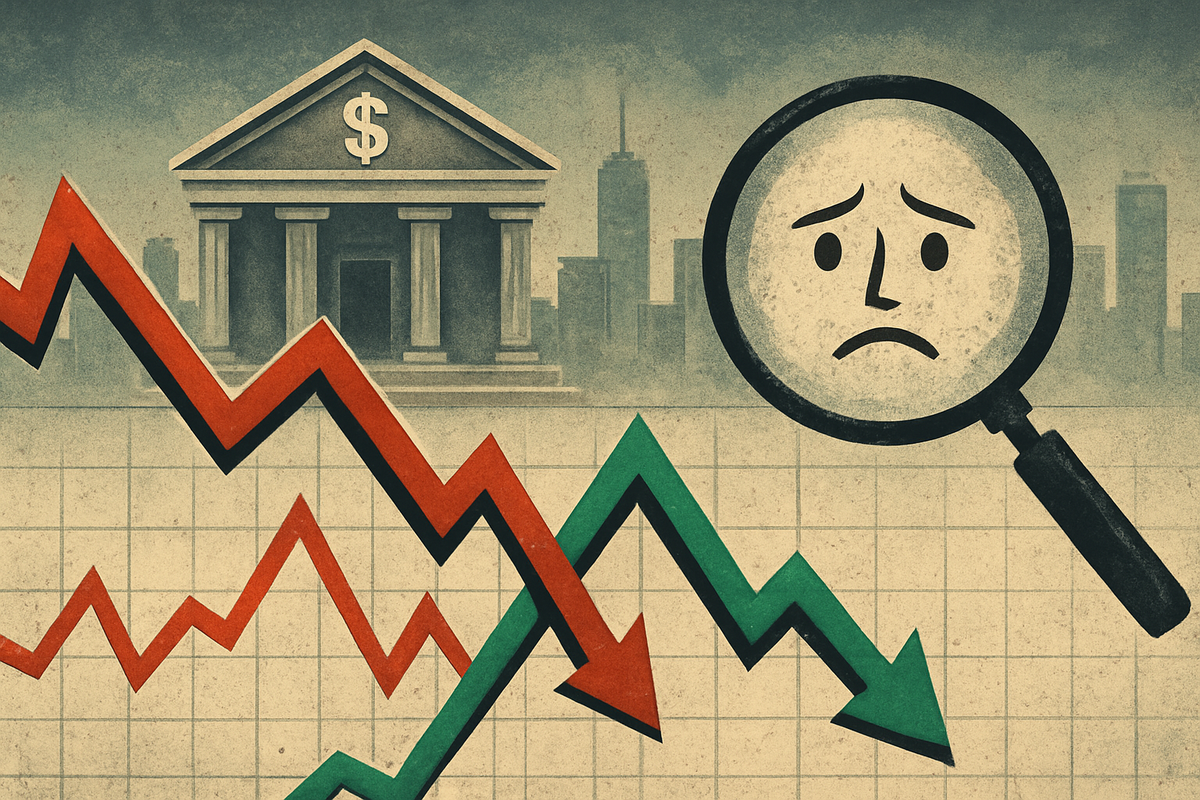
Global equity markets are currently gripped by a palpable sense of apprehension, as the specter of impending interest rate hikes by major central banks casts a long shadow over investor sentiment. This pervasive expectation is triggering significant volatility across stock exchanges, with investors grappling with the potential ramifications for corporate profitability, asset valuations, and the broader economic landscape. The delicate balance between taming persistent inflation and fostering economic growth has placed central banks in a precarious position, leaving market participants on edge and constantly re-evaluating their strategies in anticipation of policy shifts.
Central Banks Navigate a Tightrope: The Details of Monetary Policy Shifts
The current unease in equity markets is a direct consequence of evolving expectations surrounding central bank monetary policy, particularly concerning interest rates. While the US Federal Reserve recently implemented a modest 25 basis point rate cut, its accompanying communication maintained a cautious, even hawkish, tone. This has led to a notable drop in market expectations for further rate reductions in December, despite weakening economic data, including a rise in the US unemployment rate. Federal Reserve officials appear hesitant to cut rates too aggressively, citing lingering inflation concerns, thereby creating a divergence between market hopes for dovish policy and the central bank's more measured approach.
This cautious stance by the Fed, alongside similar decisions by other key central banks such as the European Central Bank and the Reserve Bank of Australia to maintain stable rates amidst inflationary pressures, paints a complex global picture. The timeline of events leading to this moment has seen a period of aggressive rate hikes in 2022 and 2023 to combat surging inflation, followed by a period of assessment and now, a cautious approach to any potential easing. Key players, including Federal Reserve Chair Jerome Powell and other central bank governors, are under intense scrutiny as their every statement is dissected for clues about future policy. Initial market reactions to these signals have been characterized by significant swings, with sectors sensitive to borrowing costs experiencing heightened volatility. The uncertainty surrounding the pace and timing of future rate adjustments has translated into persistent outflows from equity funds, as investors seek to recalibrate their portfolios in a higher interest rate environment.
Companies Navigating the Rate Hike Tides: Winners and Losers
The prospect of sustained higher interest rates creates a clear bifurcation in the corporate landscape, delineating distinct winners and losers across various sectors. Companies with robust balance sheets and those operating in essential services are generally better positioned to weather the storm, while highly leveraged entities and growth-oriented firms face significant headwinds.
Leading the charge among potential beneficiaries are Financials. Banks, such as JPMorgan Chase & Co. (NYSE: JPM) and Bank of America Corp. (NYSE: BAC), typically thrive in a rising rate environment. The mechanism is straightforward: higher interest rates allow them to charge more for loans (mortgages, credit cards, business loans) than they pay on deposits, thereby widening their net interest margins (NIMs) and boosting profitability. Similarly, insurance companies, which often hold large portfolios of interest-sensitive assets, see higher yields on their investments.
Conversely, sectors highly dependent on borrowing or future growth projections are particularly vulnerable. The Real Estate sector, encompassing developers, REITs like Simon Property Group Inc. (NYSE: SPG), and residential and commercial property firms, faces a direct hit. Higher interest rates translate to more expensive mortgages for homebuyers and increased construction loan costs for developers, dampening demand, slowing sales, and potentially depressing property values. Highly leveraged real estate investment trusts (REITs) with significant debt burdens could see their profitability eroded by escalating interest expenses.
Technology and Growth Stocks, including giants like Amazon.com Inc. (NASDAQ: AMZN) and emerging tech startups, are also on the losing end. These companies often rely heavily on external funding and debt financing for research, development, and expansion. Higher borrowing costs directly impact their operational expenses and slow growth plans. More critically, growth stocks derive much of their valuation from projected future earnings. Rising interest rates increase the discount rate used in valuation models, significantly reducing the present value of these distant future cash flows, leading to substantial downward pressure on their stock prices. Furthermore, as fixed-income assets offer more attractive yields, capital can migrate from riskier tech stocks to safer investments, exacerbating the sell-off.
Other sectors facing challenges include Utilities, which are capital-intensive and carry substantial debt, making them susceptible to increased borrowing costs. Consumer Discretionary companies, such as Starbucks Corp. (NASDAQ: SBUX) or Nike Inc. (NYSE: NKE), also suffer as higher interest rates reduce consumer disposable income, leading to decreased spending on non-essential goods and services.
A Shifting Global Financial Landscape: Broader Trends and Historical Echoes
The current environment of interest rate hike expectations and the subsequent market volatility is not an isolated event but rather a critical juncture within broader global financial trends. As of November 7, 2025, the world is witnessing a significant divergence in monetary policies among major central banks, marking a definitive end to the ultra-low interest rate era that characterized the post-2008 financial crisis period.
This divergence is a key trend. While the U.S. Federal Reserve has been actively engaged in a rate-cutting cycle, with quarter-point reductions in September and October, bringing its benchmark rate to 3.75%-4.00%, the European Central Bank (ECB) has maintained a "data-dependent holding pattern," keeping its deposit rate at 2.00% after prior cuts since June 2024. Similarly, the Bank of England (BoE) narrowly voted to maintain its Bank Rate at 4% on November 5, 2025, though some members favored a cut. This disparate approach influences currency markets, with lower U.S. rates potentially weakening the dollar and benefiting emerging markets, while countries maintaining higher rates might see their currencies strengthen.
The ripple effects extend across global supply chains. Companies heavily reliant on robust consumer spending may see their partners, from logistics providers to raw material suppliers, experience a slowdown. Conversely, businesses offering counter-cyclical products or services, such as discount retailers, could see increased demand. Economic weakness in one major economy can rapidly propagate, affecting export-oriented industries and global trade volumes. Emerging markets, while potentially benefiting from redirected capital flows due to lower U.S. rates, remain sensitive to U.S. policy risks like tariffs, which could fuel inflation and compel their central banks to maintain higher domestic rates.
Regulatory and policy implications are also profound. Central banks are meticulously balancing their mandates of inflation control and economic growth. Stronger economic data could reignite inflation fears, increasing the likelihood of aggressive rate hikes, while weaker data might prompt a more dovish stance. The elevated long-term interest rates globally are increasing government debt servicing expenses, creating budgetary pressures and constraining fiscal flexibility. The interplay between monetary and fiscal policy is further complicated by high government debt levels, and the potential for increased tariffs, particularly from the U.S., threatens to disrupt global trade and elevate prices, complicating inflation forecasts.
Historically, the current situation echoes past periods of monetary tightening. The "Volcker shock" of 1979-1982 serves as a stark precedent for aggressive rate hikes to combat inflation, which, while successful in curbing price increases, triggered a severe recession. More recently, the period of 2022-2023 witnessed an unprecedented, highly synchronized global increase in interest rates. A distinguishing feature of the current cycle, however, has been the remarkable resilience of global labor markets despite higher rates. This contrasts with historical patterns where Federal Reserve rate hikes often preceded or contributed to economic downturns. The definitive end of "financial repression" (2009-2021), characterized by ultra-low rates, marks a return to a more normalized interest rate environment, fundamentally reshaping investment paradigms and economic calculus for years to come.
Navigating the Future: Short-Term Hopes and Long-Term Realities
As of November 7, 2025, the global equity markets stand at a pivotal juncture, with the trajectory of interest rates dictating much of the short-term outlook while long-term possibilities are shaped by structural economic shifts and technological advancements. Investors are keenly watching central bank moves, particularly the U.S. Federal Reserve, which is widely expected to continue its measured rate-cutting cycle.
In the short term (next 6-12 months), the prevailing sentiment leans towards continued monetary easing, which has historically been a bullish signal for equities. Market expectations suggest the Fed funds rate could close 2025 around 3.6% and decline further by the end of 2026. This environment, characterized by rate cuts without a full-blown recession, is anticipated to particularly support U.S. stocks, especially those connected to the Artificial Intelligence (AI) theme. Smaller capitalization companies (small caps) are also projected to outperform, benefiting from the rate-cutting cycle and a steepening yield curve. Cyclical sectors, including financials and energy, are expected to continue their outperformance against defensives. However, geopolitical tensions and the potential for "higher-for-longer" borrowing costs if inflation proves stickier than expected remain significant short-term headwinds.
Looking further ahead (beyond 1-2 years), the landscape becomes more intricate. The long-term outlook suggests that fixed income investments may retain their attractiveness due to historically high rates, potentially narrowing the return advantage of equities. The AI narrative is expected to evolve, shifting from a focus on infrastructure buildout to companies that effectively utilize AI to enhance products, services, and operational efficiencies, driving top-line growth. Global diversification will be crucial, with international developed market equities projected to slightly outperform U.S. large-cap equities over the next decade due to more attractive valuations and higher expected dividend yields. The "K-shaped" economic recovery, where high-income earners and select companies thrive while others lag, is a persistent theme that will continue to influence sector performance.
Strategic pivots will be essential for investors. This includes emphasizing maximum diversification across asset classes and geographies, favoring large-cap quality stocks, and considering increased exposure to medium-duration bonds for interest income. Allocations to international equities and real assets like gold are also being considered, with gold, in particular, showing a bullish outlook. Investors may need to be prepared to pivot from growth to value strategies at the first signs of trouble, exercising caution in sectors sensitive to economic deceleration, such as industrials, and those facing structural challenges, like urban office real estate.
Market opportunities lie in AI-driven innovation, undervalued sectors like communications, real estate, and energy, and the expected resurgence of small caps and cyclicals. Challenges include high market valuations, the persistent disparities of the "K-shaped" economy, and the vulnerability of rate-sensitive industries like construction. Potential scenarios range from a "soft landing" with controlled easing, leading to broad market gains, to a "hard landing" or recessionary cuts, which would trigger significant equity market downturns. An extended "K-shaped" growth scenario, where AI continues to drive growth in specific tech sectors while others struggle, is also a possibility. Finally, an unexpected resurgence of inflation could force central banks to reverse course, challenging equity valuations and increasing borrowing costs.
The Road Ahead: Navigating a New Financial Paradigm
As of November 7, 2025, the global financial markets are navigating a landscape fundamentally reshaped by evolving interest rate expectations. The era of ultra-low rates has conclusively ended, giving way to a more dynamic and differentiated environment where monetary policy decisions, economic data, and geopolitical factors intertwine to influence market sentiment and performance.
The key takeaway is a significant shift towards an easing cycle by major central banks, particularly the U.S. Federal Reserve, which has already initiated rate cuts in September and October 2025. This transition, while generally supportive of equities, is not without its complexities. Central banks grapple with internal divisions and mixed signals, balancing persistent inflation concerns with the need to support economic growth. The resilience of labor markets, coupled with improved productivity, presents a unique backdrop for this easing cycle.
Moving forward, equity markets are likely to remain sensitive and volatile, reacting sharply to new economic data and central bank communications. The performance of growth versus value stocks will be a continuous theme, with anticipated rate cuts generally favoring growth-oriented technology companies, while defensive sectors may still offer stability amidst lingering uncertainties. Bonds, with their elevated starting yields, will continue to offer attractive alternatives, influencing capital allocation decisions. The S&P 500 (INDEXSP: .INX) may see further upside, driven by earnings growth, but valuations remain a point of debate.
The lasting impact of this period will be a renewed emphasis on fundamental value, fiscal prudence, and adaptive business strategies. Companies with strong balance sheets, effective debt management, and a capacity for innovation are best positioned for long-term success. This environment will also foster greater differentiation among companies, creating enhanced opportunities for active management and security selection. Elevated bond yields, even with rate cuts, are likely to persist, and governmental fiscal policies and geopolitical trade tensions will continue to exert significant influence on market dynamics.
Investors in the coming months should meticulously watch central bank communications for clues on future policy shifts, particularly the Federal Reserve's "dot plot" for 2026-2027. Close attention to inflation trends, especially core CPI, and any tariff-driven price increases, is paramount. Labor market data, corporate earnings reports, and broader economic indicators like GDP growth and retail sales will offer critical insights into the health of the economy. Geopolitical developments, including potential changes in U.S. trade policy, and shifts in fiscal policy in major economies also warrant careful monitoring. Finally, investors should consider adaptive portfolio strategies, potentially rotating towards sectors traditionally boosted by falling interest rates and focusing on companies with robust fundamentals that can thrive in a more differentiated market environment.
This content is intended for informational purposes only and is not financial advice







